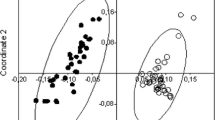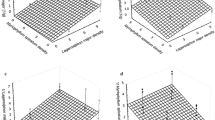Abstract
Trophic cascades may purportedly be more common in aquatic than terrestrial food webs, but herbivory on freshwater vascular plants has historically been considered low. Water lilies are an exception, suffering severe grazing damage by leaf beetles. To test whether a central prediction of cascade models—that predator effects propagate downwards to plants—operates in a macrophyte-based food web, we experimentally manipulated predation pressure on a key herbivore of water lilies in the littoral zone of a lake in Michigan, USA. Field experiments comprised combinations of caging treatments to alter the number of predators (larvae of the ladybird beetle Coleomegilla maculata) that hunt the grazers of the macrophytes (larvae of the leaf beetles Galerucella nymphaeae) on the leaves of the water lily Nuphar advena. Predatory larvae of the ladybird beetles significantly reduced grazing damage to water-lily leaves by 35–43%. The predators reduced plant damage chiefly via density-mediated effects, when lower densities of grazers translated to significant declines in plant damage. Plant damage caused by the surviving herbivores was less than predicted from individual grazing rates under predator-free conditions. This suggests that trait-mediated effects may possibly also operate in this cascade. The observed strong effect of predators on a non-adjacent trophic level concurs with an essential component of the trophic cascade model, and the cascade occurred at the ecotone between aquatic and terrestrial habitats: Nuphar is an aquatic macrophyte with emergent and floating leaves, whereas both beetle species are semi-terrestrial and use the dry, emergent and floating leaves of the water lily as habitat. Also, the cascade is underpinned by freshwater macrophytes—a group for which trophic processes have often been underappreciated in the past.




Similar content being viewed by others
References
Ballabeni P, Wlodarczyk M, Rahier M (2001) Does enemy-free space for eggs contribute to a leaf beetle’s oviposition preference for a nutritionally inferior host plant. Funct Ecol 15:318–324
Billick I, Case TJ (1994) Higher order interactions in ecological communities: what are they and how can they be detected. Ecology 75:1529–1543
Borer ET, Seabloom EW, Shurin JB, Anderson KE, Blanchette CA, Broitman B, Cooper SD, Halpern BS (2005) What determines the strength of a trophic cascade? Ecology 86:528–537
Carter MC, Dixon AFG (1984) Honeydew: an arrestant stimulus for coccinellids. Ecol Entomol 9:383–387
Chase JM (2000) Are there real differences among aquatic and terrestrial food webs? Trends Ecol Evol 15:408–412
Cronin G, Wissing KD, Lodge DM (1998) Comparative feeding selectivity of herbivorous insects on water lilies: aquatic vs. semi-terrestrial insects and submersed vs. floating leaves. Freshw Biol 39:243–257
Cyr H, Pace ML (1993) Magnitude and patterns of herbivory in aquatic and terrestrial ecosystems. Nature 361:148–150
Duffy JE (2002) Biodiversity and ecosystem function: the consumer connection. Oikos 99:201–219
Dyer LA, Letourneau D (2003) Top–down and bottom–up diversity cascades in detrital vs. living food webs. Ecol Lett 6:60–68
Evans EW, Dixon AFG (1986) Cues for oviposition by ladybird beetles (Coccinellidae): response to aphids. J Anim Ecol 55:1027–1034
Hattingh V, Samways MJ (1995) Visual and olfactory location of biotopes, prey patches, and individual prey by the ladybeetle Chilocorus nigritus. Entomol Exp Appl 75:87–98
Hodek I, Honek A (1996) Ecology of Coccinellidae. Kluwer, Boston
Hunter MD, Price PW (1992) Playing chutes and ladders: heterogeneity and the relative role of bottom–up and top–down forces in natural communities. Ecology 73:724–732
Hurlbert S (1984) Pseudoreplication and the design of ecological field experiments. Ecol Monogr 54:187–211
Hurlbert S (2004) On misinterpretation of pseudoreplication and related matters: a reply to Oksanen. Oikos 104:591–597
Hutchinson GE (1981) Thoughts on aquatic insects. BioScience 31:495–500
Juliano SA (1988) Chrysomelid beetles on water lily leaves: herbivore density, leaf survival, and herbivore maturation. Ecology 69:1294–1298
Kitchell JF, Carpenter SR (1993) Cascading trophic interactions. In: Carpenter SR, Kitchell JF (eds) The trophic cascade in lakes. Cambridge University Press, Cambridge, pp 1–14
Kouki J (1991a) The effect of water-lily beetle, Galerucella nymphaeae, on leaf production and leaf longevity of the yellow water lily, Nuphar lutea. Freshw Biol 26:347–354
Kouki J (1991b) Small-scale distributional dynamics of the yellow water-lily and its herbivore Galerucella nymphaeae (Coleoptera: Chrysomelidae). Oecologia 88:48–54
Kouki J (1991c) Tracking spatially variable resources: an experimental study on the oviposition of the water-lily beetle. Oikos 61:243–249
Kouki J (1993a) Female’s preference for oviposition site and larval performance in the water-lily leaf beetle, Galerucella nymphaeae (Coleoptera: Chrysomelidae). Oecologia 93:42–47
Kouki J (1993b) Herbivory modifies the production of different leaf types in the yellow water-lily, Nuphar lutea (Nymphaeaceae). Funct Ecol 7:21–26
Lodge DM (1991) Herbivory on freshwater macrophytes. Aquat Bot 41:195–224
Lodge DM, Cronin G, van Donk E, Froelich AJ (1998) Impact of herbivory on plant standing crop: comparison among biomes, between vascular and nonvascular plants, and among freshwater herbivore taxa. In: Jeppesen E, Sondergaard M, Christoffersen K (eds) The role of submerged macrophytes in structuring the biological community and biogeochemical dynamics in shallow lakes. Springer, Berlin Heidelberg New York, pp 149–174
Moon DC, Stilling P (2002) The influence of species identity and herbivore feeding mode on top–down and bottom–up effects in a salt marsh system. Oecologia 133:243–253
Murdie G (1971) Simulation on the effects of predators/parasite models on prey/host spatial distribution. In: Patil GP, Pielou EC, Waters WE (eds) Statistical ecology 1. Pennsylvania State University Press, Harrisburg, pp 215–223
Nechols JR, Obrycki JJ, Tauber CA, Tauber MJ (1996) Potential impact of native natural enemies on Galerucella spp. (Coleoptera: Chrysomelidae) imported for biological control of purple loosestrife: a field evaluation. Biol Control 7:60–66
Newman RM (1991) Herbivory and detritivory on freshwater macrophytes by invertebrates: a review. J N Am Benth Soc 10:89–114
Nokkala C, Nokkala S (1998) Species and habitat races in the chrysomelid Galerucella nymphaeae species complex in northern Europe. Entomol Exp Appl 89:1–13
Peacor SD (2002) Positive effect of predators on prey growth rate through induced modifications of prey behaviour. Ecol Lett 5:77–85
Polis GA (1999) Why are parts of the world green? Multiple factors control productivity and the distribution of biomass. Oikos 86:3–15
Polis GA, Sears ALW, Huxel GR, Strong DR, Maron J (2000) When is a trophic cascade a trophic cascade? Trends Ecol Evol 15:473–475
Power ME (1992) Top–down and bottom–up forces in food webs: do plants have primacy? Ecology 73:733–746
Schmitz OJ (2003) Top predator control of plant biodiversity and productivity in an old-field ecosystem. Ecol Lett 6:156–163
Schmitz OJ, Beckerman AP, O’Brien KM (1997) Behaviourally mediated trophic cascades: effects of predation risk on food web interactions. Ecology 78:1388–1399
Schmitz OJ, Hambäck PA, Beckerman AP (2000) Trophic cascades in terrestrial systems: a review of the effects of carnivore removal on plants. Am Nat 155:141–153
Schmitz OJ, Krivan V, Ovadia O (2004) Trophic cascades: the primacy of trait-mediated indirect interactions. Ecol Lett 7:153–163
Shurin JB, Borer ET, Seabloom EW, Anderson K, Blanchette CA, Broitman B, Cooper SD, Halpern BS (2002) A cross-ecosystem comparison of the strength of trophic cascades. Ecol Lett 5:785–791
Shurin JB, Gruner DS, Hillebrand H (2006) All wet or dried up? Real differences between aquatic and terrestrial food webs. P R Soc B 273:1–9
Strong DR (1992) Are trophic cascades all wet? Differentiation and donor-control in speciose ecosystems. Ecology 73:747–754
Stubbs M (1980) Another look at prey detection by coccinelids. Ecol Entomol 5:179–182
Thompson WR (1951) The specificity of host relations in predacious insects. Can Entomol 83:262–269
Trussell GC, Ewanchuk PJ, Bertness MD (2002) Field evidence of trait-mediated indirect interactions in a rocky intertidal food web. Ecol Lett 5:241–245
Underwood AJ (1997) Experiments in ecology. Their logical design and interpretation using analysis of variance. Cambridge University Press, Cambridge
Underwood AJ (1998) Design, implementation, and analysis of ecological and environmental experiments. In: Resetarits WJ Jr, Bernardo J (eds) Experimental ecology: issues and perspectives. Oxford University Press, Oxford, pp 325–349
Wallace JB, O’Hop J (1985) Life on a fast pad: waterlily leaf beetle impact on water lilies. Ecology 66:1534–1544
Wootton JT (1993) Indirect effects and habitat use in an intertidal community: interaction chains and interaction modifications. Am Nat 141:71–89
Zar JH (1996) Biostatistical analysis, 3rd edn. Prentice-Hall International (UK), London
Acknowledgments
We greatly appreciate the input of David Lodge who provided the funding (NSF grant DEB 94-08452), encouragement and logistics that made this work possible. Matt Nielsen and Erin Siska proved to be sterling field assistants under sweltering conditions. Thomas and Patricia McCauslin kindly allowed us access to the field site.
Author information
Authors and Affiliations
Corresponding author
About this article
Cite this article
Schlacher, T.A., Cronin, G. A trophic cascade in a macrophyte-based food web at the land–water ecotone. Ecol Res 22, 749–755 (2007). https://doi.org/10.1007/s11284-006-0312-5
Received:
Accepted:
Published:
Issue Date:
DOI: https://doi.org/10.1007/s11284-006-0312-5




